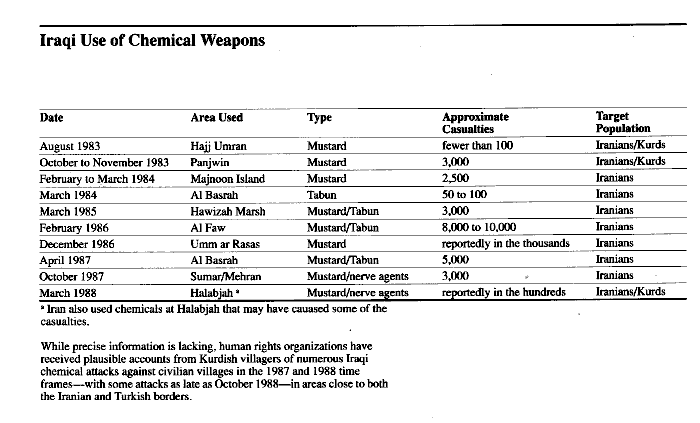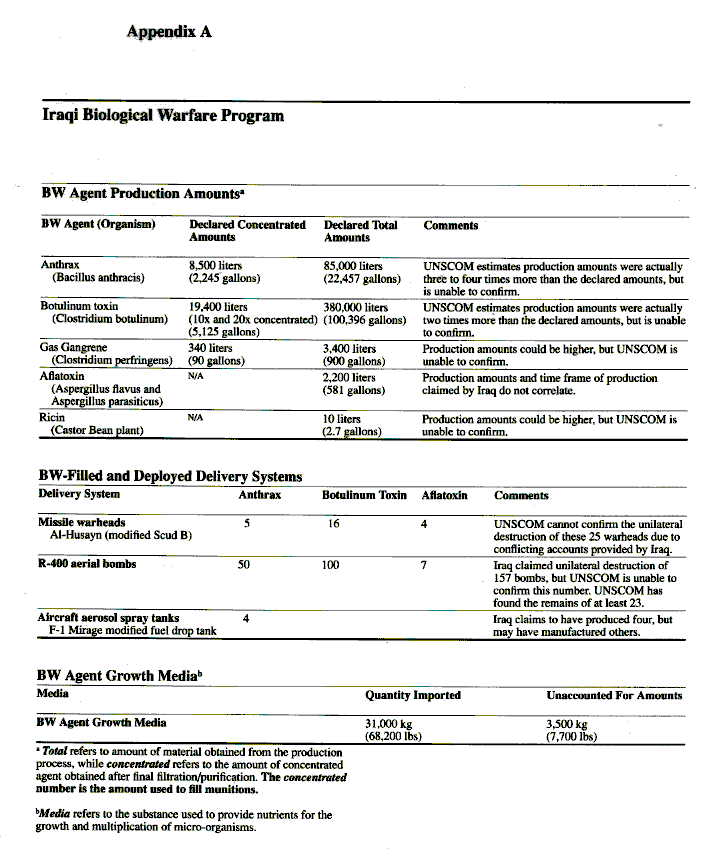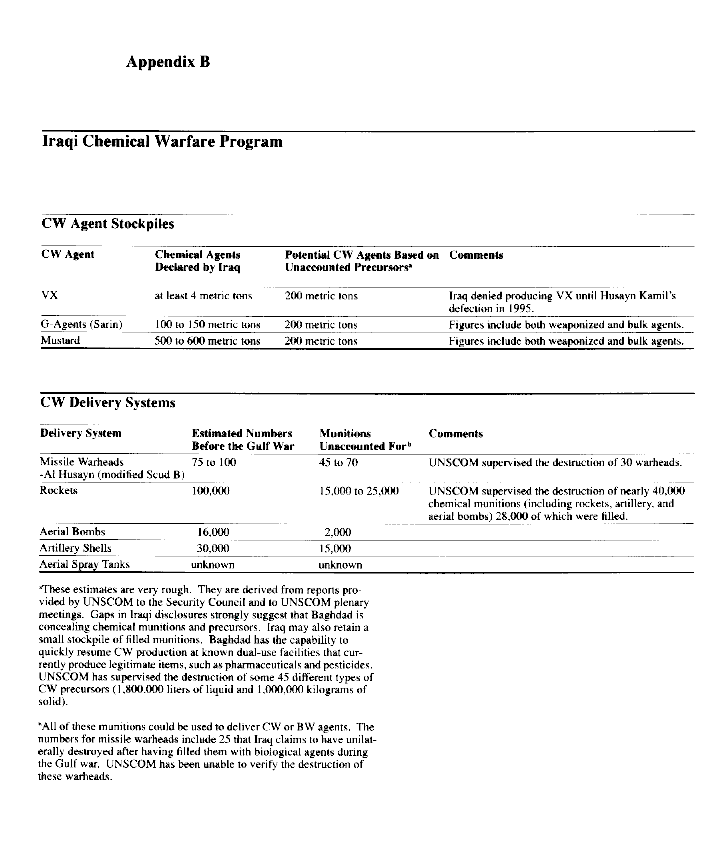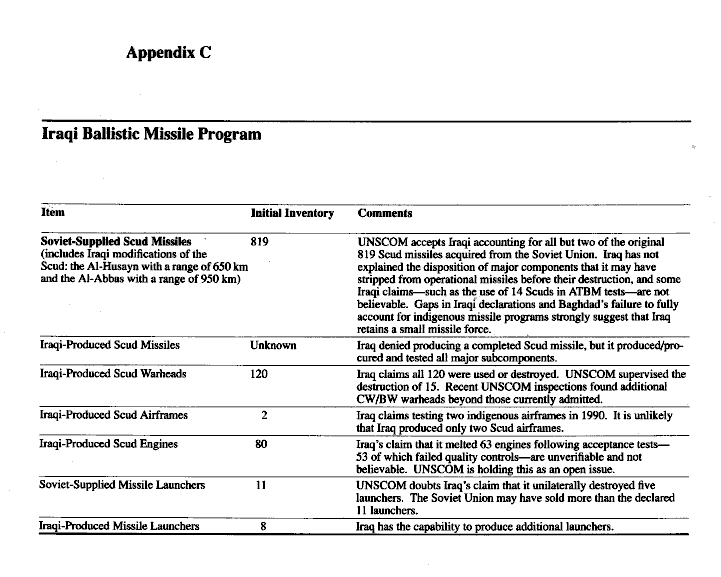

Overview
The Gulf War damaged Saddam Hussein's biological, chemical, ballistic missile, and nuclear weapons programs, collectively referred to as weapons of mass destruction (WMD). The U.N. Special Commission (UNSCOM) was established by the Security Council and accepted by Iraq following the war to eliminate and verify the destruction of Iraq's biological, chemical, and ballistic missile programs. The International Atomic Energy Agency (IAEA) assumed responsibility for dismantling Iraq's nuclear program. Further, the United Nations established sanctions to prevent the purchase of equipment and materials needed to reconstitute Baghdad's WMD programs and inspections to find remaining elements of these programs and deter further research or production related to WMD.
On the basis of the last seven years' experience, the world's experts conclude that enough production components and data remain hidden and enough expertise has been retained or developed to enable Iraq to resume development and production of WMD. They believe Iraq maintains a small force of Scud-type missiles, a small stockpile of chemical and biological munitions, and the capability to quickly resurrect biological and chemical weapons production.
This conclusion is borne out by gaps and inconsistencies in Iraq's WMD declarations, Iraq's continued obstruction of UNSCOM inspections and monitoring activities, Saddam's efforts to increase the number of "sensitive" locations exempt from inspection, and Saddam's efforts to end inspections entirely. Collectively, the evidence strongly suggests that Baghdad has hidden remnants of its WMD programs and is making every effort to preserve them. Baghdad has also enhanced indigenous capabilities and infrastructure to design and produce WMD. Saddam's strategy in dealing with UNSCOM is unchanged: he is actively trying to retain what remains of his WMD programs while wearing down the will of the Security Council to maintain sanctions.
UNSCOM and IAEA inspections and monitoring activities have severely curtailed Iraq's WMD programs, but even a small residual force of operational missiles armed with biological or chemical warheads would pose a serious threat to neighboring countries and US military forces in the region. Iraq has demonstrated its capability to employ other delivery systems. Saddam has used such weapons for tactical military purposes against Iran, and to suppress rebellious segments of his population in Kurdish-held areas.
Assessment of Cooperation With UNSCOM and the IAEA
Baghdad has a long history of obstructing UNSCOM inspections and has taken an increasingly hard line since March 1996 when the United Nations began inspecting security facilities suspected of concealing WMD-related documents and material. UNSCOM is targeting these facilities because Iraq admitted after Husayn Kamil -- Saddam's son-in-law and former head of Iraqi military industries -- defected in August 1995 that security organizations were involved in concealing material from the United Nations:
-- Resolution 687 demanded that Iraq provide declarations on all aspects of its WMD programs 15 days after the Security Council enacted the resolution in 1991. Nearly seven years later, gaps and inconsistencies remain in each of Iraq's WMD declarations covering chemical, biological, nuclear, and missile programs.
-- Baghdad has modified each declaration several times to accommodate data uncovered by UNSCOM of the IAEA and provides new information only when confronted with direct evidence. For example, Baghdad revised its nuclear declaration to the IAEA four times within 14 months of its initial submission in April 1991 and has formally submitted six different biological warfare declarations to date, each of which UNSCOM has rejected.
Baghdad has sought to constrain UNSCOM from inspecting numerous facilities since March 1996, mostly by declaring the sites "sensitive" and the inspections a violation of Iraqi sovereignty. Iraq has applied the term "sensitive" to a variety of facilities -- on one occasion security officials declared a road sensitive. Most consistently, Iraq has sought to limit U.N. access to Special Republican Guard garrisons that are responsible for executing the highest priorities of Saddam's inner circle:
-- Iraq is trying to keep the whole WMD story out of reach. UNSCOM and the IAEA have detected Iraqi officials removing documents and material from buildings, and even burning documents to prevent them from being evaluated. Inspectors have routinely found high-interest facilities cleaned out after their entry was delayed for several hours.
-- Baghdad is interested in debilitating UNSCOM's ability to monitor elements it has declared. Iraq disabled monitoring cameras and hid production equipment after expelling US inspectors from the country in November 1997.
-- Iraqi officials have interfered with inspection operations. Iraqi escort have endangered U.N. helicopter flights supporting inspections by harassing the pilot and grabbing the flight controls. Security guards have harassed inspectors on the ground.
Baghdad has tried to generate a public impression of cooperation while working hard to conceal essential information on the scope and capabilities of its WMD programs. It has allowed UNSCOM to monitor dormant WMD production facilities and has provided incomplete documentary evidence to support its claims. For example, Iraq dramatically disclosed nearly 700,000 pages of WMD-related documents following Husayn Kamil's defection. Sparse relevant information was buried within a massive volume of extraneous data all of which was intended to create the appearance of candor and to overwhelm UNSCOM's analytic resources:
-- For example, Iraq released detailed records of how many ball-point pens it ordered in the late 1980s, but it has not provided records of how it procured biological precursors or supported claims that it destroyed missile warheads capable of delivering biological and chemical agents.
-- UNSCOM and the IAEA have examined much of the documentary material and concluded that, despite advertisements to the contrary, Iraq did not release its most important WMD-related documents.
Biological Weapons
No concrete information on the scope of Iraq's biological warfare program was available until August 1995, when Iraq disclosed, after Husayn Kamil's defection, the existence of an offensive biological warfare (BW) capability. Iraqi officials admitted that they had produced the BW agents anthrax/1 (8,500 liters), botulinum toxin/2 (19,000 liters), and aflatoxin/3 (2,200 liters) after years of claiming that they had conducted only defensive research. Baghdad also admitted preparing BW-filled munitions -- including 25 Scud missile warheads (five - anthrax, 16 - botulinum toxin, four - aflatoxin), aerial bombs (157), and aerial dispensers -- during the Gulf war, although it did not use them. Iraq acknowledged researching the use of 155mm artillery shells, artillery rockets, a MiG-21 drone, and aerosol generators to deliver BW agents:
-- UNSCOM has destroyed a range of BW production equipment, seed stocks, and growth media claimed by Iraq for use in its BW programs.
-- UNSCOM believes Iraq has greatly understated its production of biological agents, and could be holding back such agents which are easily concealed.
Iraq resisted dismantling the Al Hakam BW production facility for nearly one year after disclosing in 1995 that it manufactured more than 500,000 liters of BW agents at the facility between 1989 and 1990. UNSCOM finally pressed Iraq to destroy Al Hakam in the summer of 1996:
-- Baghdad claimed that Al Hakam was a legitimate civilian facility designed to produce single-cell proteins and biopesticides.
-- Al Hakam's remote location (55 km southwest of Baghdad) and the security involved in its construction suggest that Al Hakam was intended to be a BW production facility from the outset.
Baghdad has provided no hard evidence to support claims that it destroyed all of its BW agents and munitions in 1991. UNSCOM Chairman Richard Butler stated that Iraq's most recent BW declaration, submitted in September 1997, "failed to give a remotely credible account of Iraq's biological weapons program:"
-- In late 1995, Iraq acknowledged weapons testing on Ricin, but did not provide details on the amount produced. In early 1997, two years later, UNSCOM discovered documents that showed Iraq had produced the biological agent Ricin.
-- Iraq has the expertise to quickly resume a small-scale BW program at known facilities that currently produce legitimate items such as vaccines and other pharmaceuticals. Without effective U.N. monitoring, Baghdad could probably begin production within a few days. For example, Iraq can convert production of biopesticides to anthrax simply by changing seed material.
Chemical Weapons
Iraq had an advanced chemical warfare (CW) capability that it used extensively against Iran and against its own Kurdish population during the 1980s. Iraqi forces delivered chemical agents (including Mustard 5 agent and the nerve agents Sarin and Tabun/6) in aerial bombs, aerial spray dispensers, 120-mm rockets, and several types of artillery both for tactical military purposes and to terrorize rebellious segments of the population. Iraq maintained large stockpiles of chemical munitions and had a major production capacity.

UNSCOM supervised the destruction of more than 40,000 CW munitions (28,000 filled and 12,000 empty), 480,000 liters of CW agents, 1,800,000 liters of chemical precursors, and eight different types of delivery systems -- including ballistic missile warheads -- in the past six years. Following Husayn Kamil's defection, Iraq disclosed that it:
-- Produced larger amounts of the nerve agent VX/7 than it previously admitted. Iraq acknowledged, despite previous claims that it only conducted research, that it had conducted pilot production of about 4 tons of VX from 1988 to 1990.
-- Researched in-flight mixing of binary CW weapons before the Gulf war -- an advance in the development of a CW capability that extends the shelf life of chemical agents.
-- Perfected techniques for the large-scale production of a VX precursor that is well suited to long-term storage.
UNSCOM believes Iraq continues to conceal a small stockpile of CW agents, munitions, and production equipment. Baghdad has not supplied adequate evidence to support its claims that it destroyed all of its CW agents and munitions. The destruction of as much as 200 metric tons of chemical precursors, 70 Scud warheads, and tens of thousands of smaller unfilled munitions has not been verified.
-- Baghdad retains the expertise to quickly resume CW production. In the absence of UNSCOM inspectors, Iraq could restart limited mustard agent production with a few weeks, full-scale production of sarin within a few months, and pre-Gulf war production levels -- including-VX -- within two or three years.
-- Since the Gulf war, Iraq has rebuilt two facilities it once used to produce chemical agents and has the capability to shift smaller civilian facilities to CW production.
Ballistic Missiles
Iraq had an active missile force before the Gulf war that included 819 operational Scud B missiles (300-km range) purchased from the Soviet Union, an advanced program to extend the Scud's range and modify its warhead (e.g., the Al-Husayn with a 650-km range and the Al Abbas with a 950-km range), and an extensive effort to reverse-engineer and indigenously produce complete Scud missiles. Iraq also had programs to indigenously produce long-range missiles (e.g., the Condor) that never entered the production phase:
-- UNSCOM reports that it supervised the destruction of 48 Scud-type missiles, 10 mobile launchers, 30 chemical and 18 conventional warheads, and related equipment.
-- UNSCOM has verified Iraq's unilateral destruction of only 83 Scud-type missiles and nine mobile launchers. Iraq has tried to account for the remainder by claiming the missiles were destroyed by having fired in the Iran-Iraq and Gulf wars, or used in static tests or for training.
Unmonitored unilateral destruction and discrepancies in Iraqi accounting suggest that Baghdad could still have a small force of Scud-type missiles and an undetermined number of warheads and launchers. UNSCOM believes it has accounted for all but two of the original 819 Scud missiles imported from the former Soviet Union. Iraq has not adequately explained the disposition of important missile components that it could not produce on its own and may have removed before destruction. There are still many gaps on the scope of Iraq's indigenous missile programs:
-- Iraq may have pieced together a small inventory of missiles by integrating guidance and control systems it concealed with indigenously produced parts.
-- Iraq admitted producing Scud engines, airframes, and warheads before the war, but UNSCOM has not verified claims that it destroyed all of these components.
-- Baghdad probably continues to receive some parts through clandestine procurement networks. In 1995, Jordan interdicted missile-guidance equipment (gyroscopes) bound for Iraq. Baghdad admitted under UNSCOM questioning that it received a similar shipment earlier in 1995.
-- In November 1995, Iraq turned over a previously undeclared SS-21 short-range ballistic missile launcher it acquired from Yemen before the Gulf war, illustrating Iraq's ability to conceal major elements of missile systems from UNSCOM inspectors.
Baghdad has not given up its plans to build larger, longer-range missiles. UNSCOM has uncovered numerous Iraqi design drawings, including multistage systems and clustered engine designs, that theoretically could reach Western Europe. Inspectors have uncovered evidence that Iraq has continued missile research since the imposition of sanctions. If sanctions were lifted, Iraq could probably acquire enough material to resume full-scale production of Scud-type missiles, perhaps within one year.
-- Iraq's Al-Samoud and Ababil-100 missile programs -- within the U.N.-allowed 150-km range limit -- serve to maintain production expertise within the constraints of sanctions. Iraq has apparently flight-tested the Al-Samoud -- which UNSCOM describes as a scaled down Scud -- successfully. Iraq probably will begin converting these programs into long-range production as soon as sanctions are lifted.
-- Iraq continues to expand a missile production facility at Ibn Al Haytham -- currently used to support its authorized missile programs. Two new fabrication buildings at the facility are spacious enough to house the construction of large ballistic missiles.
-- Baghdad's claim that the buildings at Ibn al Haytham are intended to be computer and administrative facilities is inconsistent with the facility's inherent size and capacity.
Nuclear Weapons
Iraq had a comprehensive nuclear weapons development program before the Gulf war that was focused on building an implosion-type weapon. The program was linked to a ballistic missile project that was the intended delivery system. After Husayn Kamil's defection in 1995, Iraq retreated from its longtime claim that its nuclear program was intended only to conduct research:
-- Iraq admitted experimenting with seven uranium enrichment techniques and was most actively pursuing electromagnetic isotope separation, gas centrifuge, and gas diffusion.
-- Baghdad planned to build a nuclear device in 1991 by using IAEA-safeguarded highly enriched uranium from its Soviet-supplied reactors.
UNSCOM and IAEA inspections have hindered Iraq's nuclear program, but Baghdad's interest in acquiring or developing nuclear weapons has not diminished:
-- Iraq retains a large cadre of nuclear engineers, scientists, and technicians who are the foundation of its nuclear program. We have concerns that scientists may be pursuing theoretical nuclear research that would reduce the time required to produce a weapon should Iraq acquire sufficient fissile material.
-- Iraq continues to withhold significant information about enrichment techniques, foreign procurement, weapons design, and the role of Iraq's security and intelligence services in obtaining external assistance and coordinating postwar concealment. Iraq continues to withhold documentation on the technical achievements of its nuclear program, experimentation data, and accounting.
-- Baghdad has not fully explained the interaction between its nuclear program and its ballistic missile program.
The Husayn Kamil Connection
Husayn Kamil Hasan al-Majid, Saddam's son-in-law, was the pre-eminent military industries official and a fundamental player in Iraq's efforts to procure weapons of mass destruction before his defection to Jordan in August 1995. A strict and capable manager, Kamil took charge of Iraq's efforts to develop its WMD program around 1987. As the head of the Ministry of Industry and Military Industrialization until 1990, he oversaw Iraq's nuclear weapons research, continued Iraq's development of biological and chemical weapons, and supervised the successful development of the Al-Husayn missile -- an indigenous modification of the Scud. During this time, it is possible that Kamil directed Iraq's testing of its chemical and biological weapons on Iranian prisoners of war.
-- After the Gulf war, Kamil -- first from his position as Minister of Defense and then as the director of the Ministry of Industry and Minerals and the Organization of Military Industrialization -- led Iraq's efforts to conceal its WMD program from international inspectors.
-- Husayn Kamil's influence over the Iraqi weapons of mass destruction program did not end with his defection in 1995. For instance, he is largely responsible for using Saddam's security services -- of which he was a member in the early 1980s -- to hide proscribed materials and documents from the United Nations.
Despite Kamil's influence, the Iraqi WMD program did not die with his defection and subsequent murder, as Iraq claims it did. Qusay Husayn -- Saddam's second son -- has assumed many of the responsibilities for concealing the proscribed programs. In addition, many of the leading scientists in Iraq's WMD programs during Husayn Kamil's tenure are still associated with the regime:
-- Lt. Gen. Amir Hamud Sadi -- who serves officially as a presidential adviser and is a leading official in Iraqi relations with UNSCOM -- was one of the principal engineers in the WMD program and essentially served as Husayn Kamil's deputy. With a doctorate in chemical engineering, Sadi has dedicated his entire career to conventional and non-conventional weapons development. In 1987, Sadi received rare public praise from Saddam for his role in the development of the Al-Husayn missile.
-- Humam Abd al-Khaliq Abd al-Ghafur -- currently Minister of Culture and Information -- is Iraq's leading nuclear official and the former head of its nuclear program. Abd al-Ghafur also was a close associate of Husayn Kamil, and he occasionally serves as an interlocutor with the IAEA, leading an Iraqi delegation to the IAEA annual conference in October 1997.
-- Jafar Dia Jafar is perhaps Iraq's foremost nuclear scientist and served as Abd al-Ghafur's deputy in the Iraqi Atomic Energy Organization. Jafar now officially serves as a presidential adviser, but his position -- unlike that of Sadi -- appears to be largely nominal.
-- Dr. Rihab Taha is the leading official in charge of Iraq's biological weapons program. She has overseen Iraqi efforts to develop anthrax and botulinum toxin and directed testing on animal subjects. Taha is also politically well-connected -- she is married to the Minister of Oil, Amir Rashid Ubaydi, who helps direct Iraqi relations with UNSCOM.



February 13, 1998
(End text)